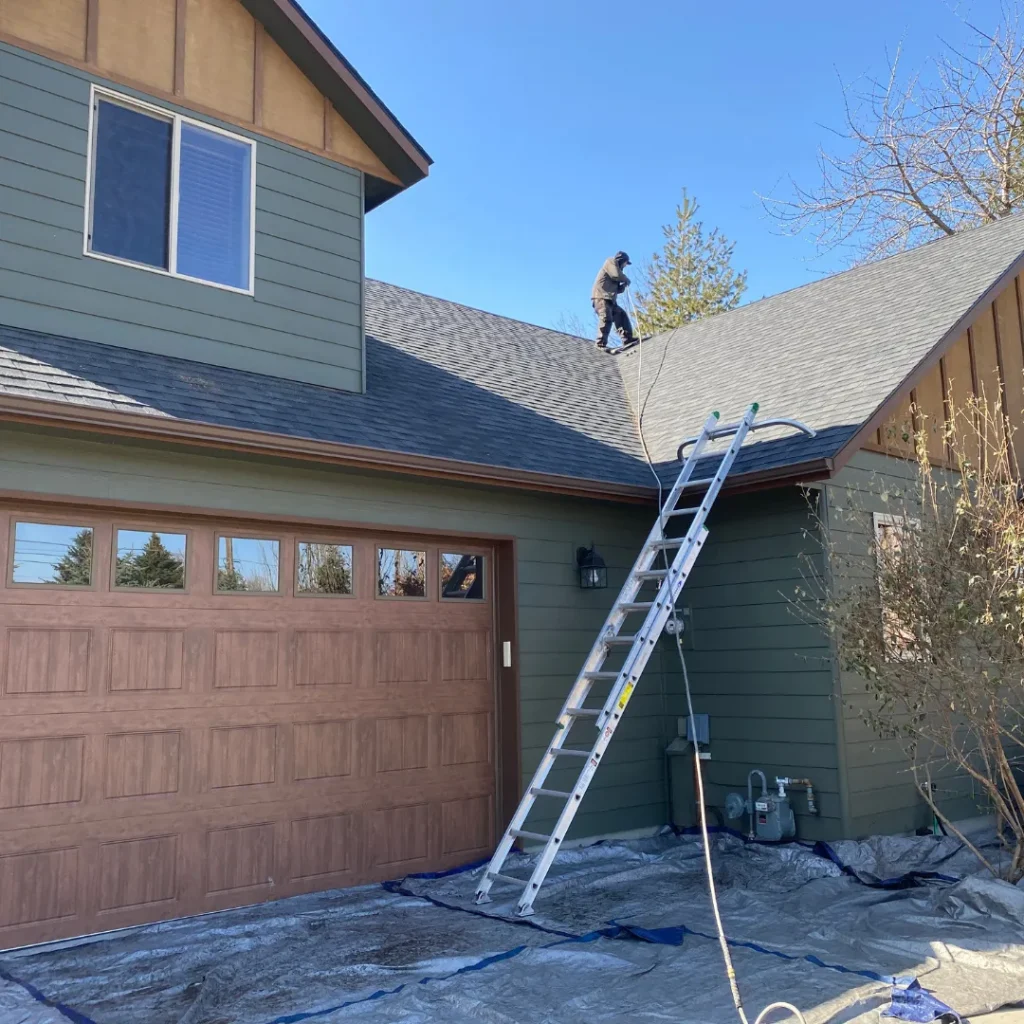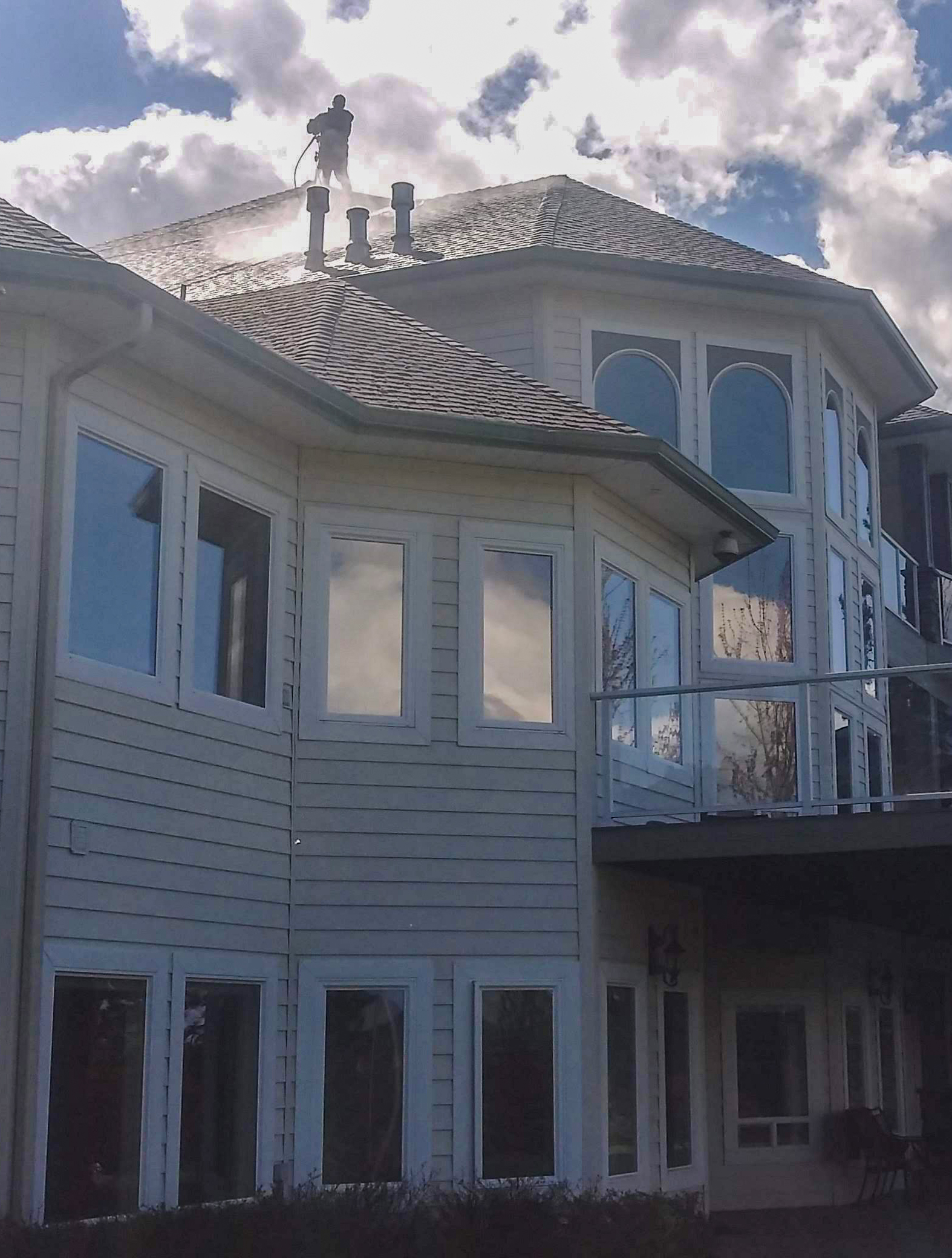Many Coeur d’Alene homeowners want to know why they should pay for a service they feel like they can do all on their own. After all, isn’t it just a matter of a little soap and water?
At Keeping It Clean, we take pride in offering the highest-quality, most reliable and affordable moss removal, pressure washing and exterior cleaning in the Coeur d’Alene area.


We service the north Idaho and eastern Washington region: Coeur d’Alene, Post Falls, Hayden, Rathdrum, Athol, Sandpoint, Liberty Lake, Spokane, Mead and more! Please feel free to contact us.
The truth is that moss removal and property cleaning takes more than soap and water. Understanding how to properly clean roofs, decks, siding, and driveways is the difference between a merely “cosmetic” wash and a genuine clean that contributes to the long-term health and longevity of your home.
Using the wrong cleaning products or methods can actually lead to further weathering and erosion of your home. Our experts at Keeping It Clean know how to evaluate the needs of your property and utilize the best products and methods to ensure that the job is done right. Keeping It Clean is licensed, insured and carries workman’s compensation.
Not all Coeur d’Alene cleaning services are created equal. Many methods not only do damage to your home, but they destroy the environment on and around your property. At Keeping It Clean, we use the most advanced eco-friendly cleaning methods in the industry. Our services will remove moss, algae, and lichen and remove stains without damaging the environment.
The simplest answer is this: if you’ve had moss professionally removed from your roof in the past, you’re looking on average at about five to six years before you’d normally notice more moss growth and need to have it removed again. At Keeping It Clean, we’ve never seen moss growth return the following year after a professional cleaning.
But five to six years is an average. Some homeowners will see moss return within three years. Others might not see moss growth return for ten.
Why is there such a difference in how fast moss grows on your roof?
Moss and algae growth depends upon the following factors:
Moss and algae depend upon moisture to grow. How fast moss spreads on your roof is directly related to the amount of rainfall your home receives in a given year. Because rainfall is rarely steady year to year, moss growth is also not consistent. Moss may thrive in a wet year, only to slow its growth considerably in a following dry year.
Moss, algae and lichen need organic material to thrive and expand. Homes with nearby trees that shed their leaves in the fall are in greater danger of rapid moss growth. It’s not just leaves that cause moss growth either. Twigs and branches collect on your roof and impede waterflow. This is why it’s so important to remove all debris from your rooftop every year. Leaves, branches and twigs will backup waterflow, create standing pools of water, and lead to the spread of moss and algae.
Like all organic life, moss needs sunlight to survive. But moss prefers shade, which is why homes with nearby trees that provide ample shade are generally at greater risk for continued moss growth.
So what’s a homeowner to do?
At Keeping It Clean, we advise all of our clients to perform annual maintenance and cleanup on their roof. Removing debris each year is essential to the proper upkeep of your roof, and it will ensure that moss and algae have little organic material to feed upon.
How often should you clean debris from your roof? In the Pacific Northwest, we recommend that you remove debris at least twice a year: once in the fall after the trees have shed their leaves, and again in the spring before heavy rains begin. Removing debris should include thoroughly cleaning all rain gutters and downspouts.
Annual Roof Maintenance:
Proper roof maintenance and cleaning will prevent the growth of moss and algae and ensure the long life of your roof. At Keeping It Clean, we offer affordable professional services not only for moss removal and roof cleaning, but for cleaning your gutters and downspouts as well. Call us anytime or fill out the form below to schedule an inspection and cleaning.
Moss, algae and lichens are all different types of growth that can be found on your roof. Each of them can damage your roof in various ways. But while most people simply see growth on their roof and assume it’s all the same, the truth is that there are subtle differences between them.
Moss is a bryophyte that develops from water-based plants. A carpet of moss is generally springy to the touch, with short tendrils shooting upwards. While moss requires water to grow, it cannot grow immersed in water.
Algae is a thallophyte and grows in water. It has no root, stem or leaves. Algae are single-celled plants that grow in clusters.
Lichen is a combination of algae and fungi. Lichen is not technically a plant at all, but rather a type of fungus that exists in a symbiotic relationship with algae. There are four types of lichen with varying appearances, and it is easy to mistake lichen for moss.
Moss, algae and lichen grow on your roof through a combination of two things: moisture and organic debris. The more water and the more debris, the greater the chance of moss growth. Another critical factor is the amount of shade your roof receives. A well-shaded roof prevents the evaporation of moisture, creating excellent conditions for moss to thrive.
Moss and algae can often be spotted from the ground, but most roofs can actually support moss growth that can remain unseen for long periods of time. This is because moisture gets under your shingles and allows moss to grow out of the light of the sun. For this reason, evaluating moss growth on your roof takes more than just glancing up and taking a look.
Moss damages your shingles in three significant ways.
First, moss will strip away the protective oils on your shingles, making them susceptible to erosion and sun damage. Without any protection, your shingles will warp and crack in the sun, significantly shortening their lifespan.
Second, moss absorbs water. So every time it rains, the moss sucks up more moisture and spreads farther across your shingles, eating away at this outer protective layer. If ignored, this moisture buildup will ruin your shingles, and you will eventually need to replace your roof.
Finally, moss spreads beneath your shingles. This moss absorbs water and thus allows moisture to invade into the interior of your home. When moisture builds up on the inside of your home, it leads to wood rot. This is the worst case scenario because it can mean far more extensive (and far more costly) repairs to your home.
Now that you have a better understanding of how moss grows on your roof, the next question is how can you prevent moss from growing in the first place. Homeowners can take two approaches to prevent moss growth.
First, keep your roof clean. Removing buildup and debris on your roof goes a long way in ensuring that moss, algae and lichen have less of a chance of spreading. At least twice a year, be sure to clean out your gutters and downspouts. Remove fallen leaves, twigs, and branches from your roof. Look for punctures, broken shingles or tiles, and other kinds of damage that might allow in moisture. Patch all damage properly.
Second, hire a professional roof cleaning service to remove moss and algae buildup. A professional roof cleaner has specialized equipment that will remove all the grime, dirt, stains, moss and algae from your roof, and industrial cleaners that are environmentally friendly but will kill moss and algae down to the root. This kind of cleaning both removes restores the original luster of your roof and increases its longevity.


Monday – Saturday:
7:00AM – 7:00PM
Sunday:
9:00AM – 5:00PM